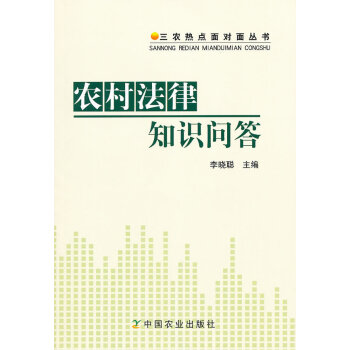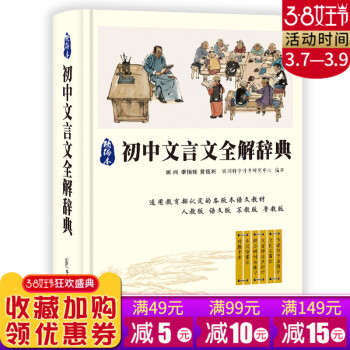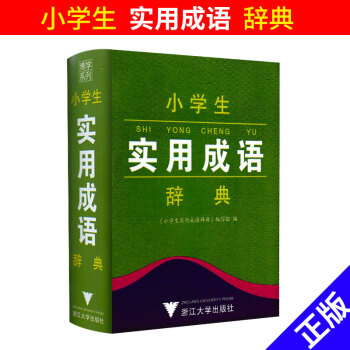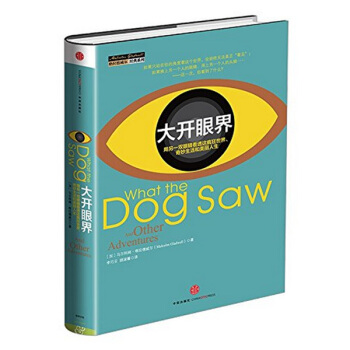具体描述
![]()
基本信息
书名:农村法律知识问答
定价:12元
作者:李晓陪 主编
出版社:中国农业出版社
出版日期:2011-10-1
ISBN:9787109160897
字数:67000
页码:127
版次:1
装帧:平装
开本:32开
商品重量:
编辑推荐
内容提要
本丛书紧密联系我国农业、农村形势的新变化,重点围绕发展现代农业和推进社会主义新农村建设,对当前农民和农村干部普遍关注的党的强农惠农政策、农业生产、乡村管理,农民增收和社会保障以及新技术应用等热点难点问题,采用专家与读者面对面交流的形式,理论联系实际,进行深入浅出的回答,观点准确、说理透彻,文字生动、事例鲜活, 图文并茂、通俗易懂,具有较强的针对性和说服力。在运作方式上,根据理论联系实际的要求,针对“三农”问题的阶段性特点,分期分批组织实施。丛书突出科学性、针对性、实用性,力求用新技术、新观点、新形式,达到“贴近农业实际、贴近农村生活、贴近农民群众”的要求。
本丛书是广大基层干部、农民和农业院校师生学习和了解理论和形势政策的重要辅助材料,也是社会各界了解“三农”问题的重要窗口。希望本丛书的出版对推动“三农”工作的开展和“三农”问题的研究提供有力的智力支持,也希望广大读者提出好的意见和建议,以便我们更好地改进工作,服务“三农”。
目录
一、村民自治
村的党组织、村委会与农村集体经济组织是什么?
关系?村委会与乡镇政府是什么关系?
村民委员会有哪些职责和义务?
法律对村民委员会的组成、成员任期
是如何规定的?
村民委员会如何产生,
如何确定村民委员会成员候选人?
村民委员会主任和村党委书记能否为一人?
如何罢免村民委员会成员?
哪些村民享有选举权私被选举权?
什么情况下构成违法选举?
村民会议的职权是什么
法律对村民代表会议是如何规定的?
什么是村务公开制度?
村民委员会任期和离任经济责任审计的
事项包括哪些?
……
二、土地承包经营权和宅基地
三、民事经济
四、婚姻家庭继承
五、农民工保护
六、农民权益保护
七、法律责任
作者介绍
文摘
序言
《 Rural Law Knowledge Q&A 》 - A Comprehensive Guide for Farmers Introduction In the vast and fertile lands of rural China, agriculture remains the bedrock of the nation's economy and the livelihood of millions. Yet, the intricacies of legal frameworks, often perceived as distant and complex, can pose significant challenges for farmers navigating their daily lives and businesses. From land ownership disputes and contract agreements to labor rights and environmental regulations, a solid understanding of rural law is not merely an advantage, but a necessity for ensuring stability, fairness, and prosperity. Recognizing this critical need, "Rural Law Knowledge Q&A," authored by Li Xiaopei and published by China Agriculture Press, stands as an indispensable resource for every farmer and rural resident. This meticulously crafted book demystifies the legal landscape, offering clear, concise, and practical answers to the most common and pressing legal questions encountered in rural settings. It serves as a beacon of knowledge, empowering individuals with the information they need to protect their rights, fulfill their obligations, and contribute to a more just and harmonious rural society. Content Overview: A Deep Dive into Rural Legalities "Rural Law Knowledge Q&A" is not a dry, academic treatise. Instead, it adopts an accessible and engaging question-and-answer format, making complex legal concepts digestible and relatable. The book systematically addresses a broad spectrum of legal issues, ensuring that readers can easily find the information relevant to their specific circumstances. I. Land Rights and Management: The Foundation of Rural Life Land is the most precious asset for most rural households. This section delves into the fundamental legal aspects of land ownership, usage, and management, providing clarity on a range of critical topics: Land Ownership and Property Rights: The book explains the intricacies of land ownership in China, including the distinction between state-owned land and collectively owned land. It clarifies the rights and responsibilities associated with occupying, using, and managing these lands. Readers will understand the legal basis of their land tenure, how land is allocated, and the procedures for obtaining rights to use land for agricultural purposes, housing, or other approved activities. Land Use Contracts: A significant portion of rural economic activity revolves around land use contracts. This section thoroughly examines the legal framework governing these agreements, covering: Formation and Content of Contracts: What essential clauses should be included in a land use contract? What are the rights and obligations of both the land-granting entity and the contract holder? Duration and Renewal: Understanding the legal term of land use contracts and the procedures for their renewal is crucial for long-term planning. Modification and Termination: The book details the legal grounds for modifying or terminating land use contracts, including compensation mechanisms in cases of termination initiated by the state or collective. Subcontracting and Transfer: Farmers often engage in subcontracting or transferring land use rights. This section clarifies the legal requirements and implications of such arrangements, ensuring that these transactions are valid and protect the interests of all parties involved. Land Expropriation and Compensation: Land expropriation for public projects is a reality in developing rural areas. The book provides essential legal knowledge regarding: Legal Procedures: What are the legal procedures for land expropriation? What rights do farmers have during this process? Compensation Standards: Understanding the legal basis for compensation, including land compensation, resettlement subsidies, and young crop/standing crop compensation, is vital for ensuring fair treatment. Appeals and Grievances: This section empowers farmers with information on how to appeal against decisions they believe are unfair or illegal, and how to seek redress through legal channels. Rural Housing and Property: Beyond agricultural land, rural residents also own and occupy housing. The book addresses legal questions related to: Construction and Renovation: What are the legal requirements and permits needed for building or renovating rural housing? Property Rights: Clarifying the legal ownership and transfer of rural housing, especially in the context of family inheritance. Disputes over Housing: The book provides guidance on resolving disputes related to boundaries, usage, and ownership of rural homes. II. Agricultural Production and Operations: Ensuring Fair Trade and Sound Practices The success of agricultural production hinges not only on hard work and good farming practices but also on a clear understanding of related legal frameworks governing contracts, product quality, and market access. Agricultural Contracts: This section focuses on the legal aspects of various agricultural contracts, including: Purchase and Sale Contracts: Ensuring fair prices and reliable delivery for agricultural products. Contract Farming Agreements: Understanding the terms and conditions of agreements where farmers produce crops for specific buyers. Leasing of Agricultural Machinery: Legal considerations for renting and operating agricultural equipment. Product Quality and Safety: The book emphasizes the importance of legal compliance in ensuring agricultural product quality and safety, addressing: Food Safety Regulations: Key legal requirements and standards for producing and selling food products. Liability for Defective Products: What recourse do consumers have if they suffer harm due to defective agricultural products? What are the responsibilities of producers? Agricultural Insurance: The book explores the legal framework surrounding agricultural insurance, helping farmers understand: Types of Insurance: Different insurance products available to mitigate risks associated with natural disasters, pests, and diseases. Claim Procedures: How to file an insurance claim and what legal documentation is required. Intellectual Property in Agriculture: With the increasing use of improved seed varieties and agricultural technologies, understanding intellectual property rights is becoming more relevant. The book touches upon: Plant Variety Protection: Legal safeguards for new plant varieties and the rights of breeders. III. Labor and Employment in Rural Areas: Protecting Workers' Rights Rural areas often involve diverse forms of labor, from traditional farming to construction and service industries. This section provides essential legal knowledge to protect the rights of both employers and employees. Labor Contracts: The book clarifies the legal requirements for establishing valid labor contracts, including: Content and Form: What essential elements must be included in a labor contract? Wages and Benefits: Legal standards for minimum wage, overtime pay, and other benefits. Working Hours and Rest Periods: Ensuring compliance with regulations on working time. Termination of Labor Contracts: Legal procedures and grounds for terminating labor contracts, including notice periods and severance pay. Occupational Safety and Health: Protecting workers from workplace hazards is a legal imperative. This section addresses: Employer Responsibilities: Legal obligations of employers to provide a safe working environment. Worker Rights: The right of workers to a safe workplace and to refuse unsafe work. Accident Reporting and Investigation: Procedures for reporting and investigating work-related accidents. Social Security for Rural Workers: The book provides an overview of social security schemes available to rural workers, including: Pension Schemes: Understanding eligibility and benefits. Medical Insurance: Accessing healthcare through rural medical insurance programs. Unemployment Benefits: Eligibility and procedures for claiming unemployment benefits. IV. Rural Governance and Collective Economy: Participating in Local Development The functioning of rural communities is often guided by collective organizations and local governance structures. This section empowers residents with knowledge about their rights and responsibilities within these systems. Village Committees and Village Affairs Management: The book explains the legal status and functions of village committees, and how residents can participate in village decision-making processes. Collective Economic Organizations: Understanding the legal framework governing collective enterprises, cooperatives, and other forms of rural collective economy. Rural Collective Property Management: Legal aspects of managing and utilizing collective assets. V. Environmental Protection and Resource Management in Rural Areas: Sustainable Development Sustainable development in rural areas necessitates a strong understanding of environmental laws and regulations. This section covers key legal aspects related to environmental protection: Water Resource Management: Legal frameworks for water usage, pollution control, and protection of water sources. Waste Management: Regulations on solid waste disposal, recycling, and the prevention of environmental pollution. Protection of Agricultural Biodiversity: Legal measures for preserving valuable plant and animal genetic resources. Legal Responsibilities for Environmental Damage: Understanding liability for environmental pollution and the procedures for seeking redress. VI. Rural Disputes Resolution and Legal Aid: Seeking Justice and Support When disputes arise, knowing how to effectively resolve them is crucial. This section provides practical guidance on accessing legal assistance and navigating the justice system. Mediation and Arbitration: Exploring alternative dispute resolution mechanisms common in rural areas. Civil Litigation: An overview of the civil court process for resolving legal disputes. Legal Aid Services: Information on how to access free or low-cost legal assistance for those who cannot afford legal representation. Consumer Rights Protection: Legal recourse for consumers facing issues with products or services. Conclusion: Empowering Rural China "Rural Law Knowledge Q&A" by Li Xiaopei is more than just a book; it is a tool for empowerment. By equipping farmers and rural residents with practical legal knowledge, it enables them to make informed decisions, protect their rights, and contribute to the sustainable and equitable development of rural China. The book's accessible language, comprehensive coverage, and practical approach make it an invaluable companion for anyone living and working in rural areas. It fosters a greater sense of legal awareness, promotes fairness, and ultimately strengthens the foundation of rural communities across the nation. This is a definitive guide, designed to serve the needs of the people it aims to assist, ensuring that the pursuit of justice and well-being in rural China is guided by knowledge and empowered by law.






















